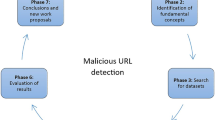Abstract
In this article, the authors propose an approach to the security analysis of program code using vector representations of machine instructions. The article also proposes a method for constructing multidimensional vector spaces for a set of program code instructions. The construction of semantically expressive vector representations of machine instructions is considered as one of the important tasks in constructing a neural network code classifier for vulnerabilities. The applicability of the principle of transfer learning to machine code is demonstrated experimentally.



Similar content being viewed by others
REFERENCES
Pechenkin, A.I. and Nikolskiy, A.V., Architecture of a scalable system of fuzzing network protocols on a multiprocessor cluster, Autom. Control Comp. Sci., 2015, vol. 49, no. 8, pp. 758–765.
Deep Learning on Disassembly, Black Hat USA, 2015. https://www.blackhat.com/docs/us-15/materials/us-15-Davis-Deep-Learning-On-Disassembly.pdf.
Chappell, T., et al., An Inital Exploration into Machine Learning for the Purposes of Finding Bugs in Source Code, Oracle Labs, 2016.
Xuan Huo, Ming Li, and Zhi-Hua Zhou, Learning unified features from natural and programming languages for locating buggy source code, Proceedings of the Twenty-Fifth International Joint Conference on Artificial Intelligence (IJCAI’16), Brewka, G., Ed., 2016, pp. 1606–1612.
Ng, A.Y., et al., Deep Speech: Scaling up end-to-end speech recognition, Presentation from a SF Meetup hosted event at NVIDIA (October 6th, 2015).
Bengio, Y., Cho, K., and Bahdanau, D., Neural machine translation by jointly learning to align and translate, International Conference on Learning Representations, 2015.
Blunsom, P., Grefenstette, E., and Kalchbrenner, N., A convolutional neural network for modelling sentences, The 52nd Annual Meeting of the Association for Computational Linguistics, 2014.
Kumar, A., Irsoy, O., Ondruska, P., Iyyer, M., Bradbury, J., Gulrajani, I., and Socher, R., Ask me anything: Dynamic memory networks for natural language processing, arXiv preprint arXiv:1506.07285, 2015.
Bottou, L., From machine learning to machine reasoning, J. Mach. Learn., 2014, vol. 94, no. 2, pp. 133–149.
Mikolov, T., Wen-Tau Yih, S., and Zweig, G., Linguistic regularities in continuous space word representations, Proceedings of the 2013 Conference of the North American Chapter of the Association for Computational Linguistics: Human Language Technologies (NAACL-HLT-2013).
Thang Luong, Socher, R., and Manning, C.D., Better word representations with recursive neural networks for morphology, CoNLL 2013, pp. 104–113.
Mikolov, T., Chen, K., Corrado, G., and Dean, J., Efficient estimation of word representations in vector space, Proceedings of Workshop at ICLR, 2013.
Sinno Jialin Pan and Qiang Yang, A survey on transfer learning, IEEE Trans. Knowl. Data Eng., 2010, vol. 22, no. 10, pp. 1345–1359.
ACKNOWLEDGMENTS
This work is supported by the Russian Science Foundation under grant no. 17-71-10065.
Author information
Authors and Affiliations
Corresponding authors
Additional information
The article was translated by the authors.
About this article
Cite this article
Demidov, R.A., Pechenkin, A.I. An Approach to the Programs Security Analysis using Vector Representation of Machine Code. Aut. Control Comp. Sci. 52, 1010–1016 (2018). https://doi.org/10.3103/S0146411618080096
Received:
Published:
Issue Date:
DOI: https://doi.org/10.3103/S0146411618080096




